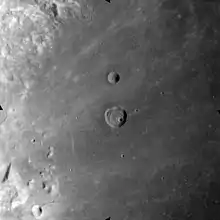Peirce (crater)
Peirce is a small lunar impact crater in the western part of Mare Crisium. That dark, circular lunar mare is located in the east-northeasterly part of the Moon's near side. It was named after the American mathematician Benjamin Peirce.[1] Peirce lies to the north of the craters Yerkes and Picard, and southeast of Macrobius located outside the mare. Just over a crater diameter to the north of Peirce is the smaller Swift. To the northwest is the wrinkle ridge Dorsum Oppel.
 Apollo 17 mapping camera image | |
| Coordinates | 18.3°N 53.5°E |
|---|---|
| Diameter | 19 km |
| Depth | 1.8 km |
| Colongitude | 307° at sunrise |
| Eponym | Benjamin Peirce |

The rim of Peirce is roughly circular, with a slight outward bulge along the northwestern rim. There are indications of slumping along the sides of this section, producing a wider inner wall. It is generally bowl-shaped, and is marked only by a tiny craterlet along the inner southeast rim. The interior is marked by several furrows, ridges, as well as a low, conical hill near the midpoint.
Peirce is a crater of Eratosthenian age.[2]
Satellite craters
By convention these features are identified on lunar maps by placing the letter on the side of the crater midpoint that is closest to Peirce.
| Peirce | Latitude | Longitude | Diameter |
|---|---|---|---|
| C | 18.8° N | 49.9° E | 19 km |
The following craters have been renamed by the IAU.
- Peirce B — See Swift (lunar crater).
References
- "Gazetteer of Planetary Nomenclature | Peirce". usgs.gov. International Astronomical Union. Retrieved August 23, 2017.
- The geologic history of the Moon. USGS Professional Paper 1348. By Don E. Wilhelms, John F. McCauley, and Newell J. Trask. U.S. Government Printing Office, Washington: 1987. Table 12.2.
- Andersson, L. E.; Whitaker, E. A. (1982). NASA Catalogue of Lunar Nomenclature. NASA RP-1097.
- Bussey, B.; Spudis, P. (2004). The Clementine Atlas of the Moon. New York: Cambridge University Press. ISBN 978-0-521-81528-4.
- Cocks, Elijah E.; Cocks, Josiah C. (1995). Who's Who on the Moon: A Biographical Dictionary of Lunar Nomenclature. Tudor Publishers. ISBN 978-0-936389-27-1.
- McDowell, Jonathan (July 15, 2007). "Lunar Nomenclature". Jonathan's Space Report. Retrieved 2007-10-24.
- Menzel, D. H.; Minnaert, M.; Levin, B.; Dollfus, A.; Bell, B. (1971). "Report on Lunar Nomenclature by the Working Group of Commission 17 of the IAU". Space Science Reviews. 12 (2): 136–186. Bibcode:1971SSRv...12..136M. doi:10.1007/BF00171763. S2CID 122125855.
- Moore, Patrick (2001). On the Moon. Sterling Publishing Co. ISBN 978-0-304-35469-6.
- Price, Fred W. (1988). The Moon Observer's Handbook. Cambridge University Press. ISBN 978-0-521-33500-3.
- Rükl, Antonín (1990). Atlas of the Moon. Kalmbach Books. ISBN 978-0-913135-17-4.
- Webb, Rev. T. W. (1962). Celestial Objects for Common Telescopes (6th revised ed.). Dover. ISBN 978-0-486-20917-3.
- Whitaker, Ewen A. (1999). Mapping and Naming the Moon. Cambridge University Press. ISBN 978-0-521-62248-6.
- Wlasuk, Peter T. (2000). Observing the Moon. Springer. ISBN 978-1-85233-193-1.
External links
- LTO-44D4 Peirce — L&PI topographic map
- Peirce Crater: Apollo 17 vs. Lunar Orbiter 4 (accessed 10/04/05.)
